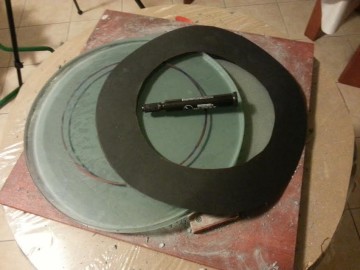In the past 1/3 COC, the movement of the mirror on the tool (being the focal reduction) or viceversa (in the process of increase of the focal) They must be made by following a few simple but important rules:
- the center mirror and the tool at each pass must meet and the straight line virtually drawn from the center of the disc at that moment is in motion must be transferred from the stationary center of the disc or by moving them laterally slightly;
- the disc outward and return movement must not be abruptly locked in the two end of stroke: so no mechanical blocks to limit the stroke to the fateful 1/6 the swiveling out from the disc that lies beneath. So the ooze of 1/6 diameter and outward equally in return must be determined by eye!
- the sum of the small amplitude errors of past return (ie the deviations from the exact swiveling out of 1/6 diameter pushing the disc and 1/6 if pulling) You must be compensated, to zero in the thousands of past and, at the end of the sphere creating jobs, we will run.
Then, in summary, past in return will inevitably be conducted in a free hand and the point of “reverse” (ie reached the ooze of 1 / 6d) It will be determined by eye.
Exists, in this case, a simple method that can help in identifying the right inaccuracy (remember? many small offsetting errors that cancel up to zero….) the point at which end a past and begin the next in the opposite direction.
It must first adopt a fairly stiff card (it is sufficient that it is stiffer than a sheet of paper, to speak) and cut out a disk of diameter equal to our mirror. Subsequently it will be clipped internally another disc with a diameter equal to D = Dspecchio-1 / 3Dspecchio (in the case of past 1/3 COC; if it were, for example, 1 / 2COC will be D = Dspecchio-1 / 2Dspecchio). This will result in a cardboard ring, that we are going to lay on the mirror smooth surface (or tool, if we are in the process of reducing the focal), aligning the two perimeters. With a black marker (indelible but not too much….) then we are going to draw on the glass disk a circle while being guided by the inner edge of cartonboard. Eventually we will have, then, a concentric circle at the perimeter of the mirror drawn on the non-machined mirror, internal 2 / 3Dspecchio diameter.
How it will guide us in the past this circle drawn on our mirror (or tool)?
PROCEED WITH THE WORK
abrasive, water and away with the past. To determine the reversal point of the “direction of travel” the past, We exploit the mirror transparency, that will allow us to follow the contour of the disk remained under and firm. Once the cercio drawn reaches the edge of the disc below, will now time to stop the race, and to reverse the route, beginning the next pass of opposite sign.
A video, in this case, It explains much better than a thousand words.
(Nb: pay no attention to the position of the hands on the mirror, This video was made only for the purpose of showing the operation of the system shown)
